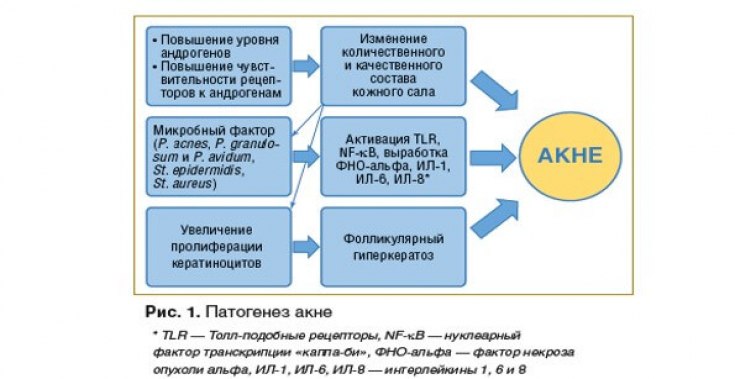Acne occurs as a result of the action of hormones and other substances on the sebaceous glands.
These changes lead to clogged pores and acne of varying severity. They usually appear on the face, neck, back, chest and shoulders.
While acne does not pose a health risk, it can cause psychological discomfort, especially as severe acne often results in scarring.
While women are statistically more likely to develop acne, men are more likely to develop severe acne due to the amount of circulating testosterone.
On estet-portal.com read what subtleties of acne treatment are men.
- Men's and women's skin: why men's acne is more severe
- Acne pathogenesis: what should acne treatment be aimed at
- Peculiarities of acne therapy in menn
Men's and women's skin: why male acne is more severe
The main difference between male and female skin, apart from thickness, is the effect of male sex hormones, collectively known as androgens. The main sex hormone of this group is testosterone.
Despite the fact that its concentration varies in different men, adult men produce ten times more testosterone than women.
Testosterone acts on androgen receptors, either directly or by converting to dihydrotestosterone (DHT), a much more potent androgen receptor activator.
It is generally accepted that women are more likely to seek medical attention for skin-related problems due to social norms, while men are less likely to present these problems to a professional until the disease becomes severe.
Androgens, including testosterone, lead to the formation of a more compact network of collagen fibers in men, as opposed to women's skin. This resilient network of collagen and elastin makes men's skin thicker.
Androgens also increase sebum secretion and change the physico-chemical characteristics of sebum, making it more viscous.
As a result of these biological differences, men are more likely to develop acnep.
Acne: mechanism of development and predisposing factors
Acne pathogenesis: what should acne treatment be aimed at
The pathogenesis of Acne vulgaris is multifactorial, the disease develops as a result of the interaction of the following four factors:
- chronic inflammation;
- follicular hyperkeratinization after follicle blockage;
- excessive production of sebum;
- colonization of follicles by Propionibacterium acnes.

Studies show that inflammation occurs before hyperkeratinization.
Cytokines produced by CD4+ T cells and macrophages activate local endothelial cells to upregulate inflammatory mediators.
Follicular hyperkeratinization entails increased growth of keratinocytes and reduced desquamation, leading to microcomedones.
Excess sebum is another factor influencing the progression of acne vulgaris.
The creation of anaerobic conditions due to blockage of the sebaceous gland excretory duct by excess sebum and keratinocytes, contributes to the reproduction of Propionibacterium acnes.
Read the most interesting articles in Telegram!
Peculiarities of acne therapy in men
Treatment should be directed to all known pathogens associated with acne.
While women are more prone to acne, men are more likely to develop severe acne due to the influence of circulating androgens.
Due to the potential for more severe disease and the risk of scarring, oral isotretinoin may be the first line of treatment. However, many patients are concerned about possible side effects.
Combination of low dose isotretinoin (20mg once daily) with topical tretinoin (0.025% in ointment base) works well.
Patients may stay on treatment longer and are more likely to adhere to treatment protocol and thus achieve the ultimate goal of acne symptom control.
Acne in women of reproductive age: features of the disease







Add a comment